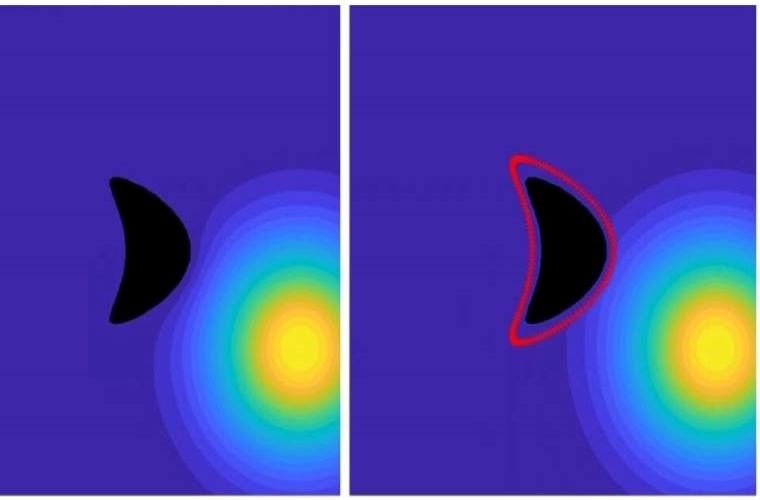From Harry Potter’s invisibility cloak to the technology dreamed up by Star Trek creator Gene Roddenberry to cloak Romulan warbirds and Klingon Birds of Prey, science fiction characters often can render a person, or even an entire spaceship, invisible.
In reality, this type of ‘visual’ cloaking, where light is bent around an object to hide it from the naked eye, is already being studied, with mixed results. And as any sci-fi fan will tell you, once an object is rendered invisible in this manner, interstellar predators often switch over to the infrared spectrum to track their prey through the heat they emit.
To combat this problem, as well as a host of other related issues, researchers from the University of Utah have worked out a method to ‘thermally cloak’ an object in space, making it either invisible or appear like a completely different object altogether. And, instead of previous attempts that use bulky or complex equipment, the team has developed a simplified process that they say is within our current technological ability.
“We present an active cloaking method for the parabolic heat (and mass or light diffusion) equation that can hide both objects and sources,” reads the study published in Proceedings of the Royal Society A: Mathematical, Physical and Engineering Sciences. “The same technique can be used to make a source or an object look like a different one to an observer outside the cloaked region, from the perspective of thermal measurements.”


Background: I can See You. Can You See Me?
Funded by the National Science Foundation and supported by an international group of applied mathematicians and physicists, including Fernando Guevara Vasquez and Trent DeGiovanni from the University of Utah, the study first looked at the fundamentals of the thermal cloaking problem. Fortunately, the relatively similar dynamics of heat energy and light energy meant that the problem could at least be approached in the same manner as visual cloaking.
“Just as our eyes see objects if they emit or reflect light, a thermal camera can see an object if it emits or reflects infrared radiation,” the study’s press release explains. “In mathematical terms, an object could become invisible to a thermal camera if heat sources placed around it could mimic heat transfer as if the object wasn’t there.”
Analysis: What is Thermal Cloaking?
To accomplish their theoretical thermal cloaking, the team used readily available materials known as heat pumps to hide the objects, rather than starting with any exotic or specially designed material like is often employed to bend or manipulate light. Heat pumps, the research explains, are also more flexible than carefully crafted or otherwise custom-made materials.
“A simple household example of a heat pump is a refrigerator,” the study explained. “To cool groceries, it pumps heat from the interior to the exterior.”
For their research, the team used small heat pumps known as ‘Peltier elements,’ which cannot only move and control the heat by passing an electrical current across a metal-metal junction but are already widely used in industrial and consumer applications. Then, by placing these Peltier elements around an object to absorb and redirect the heat being emitted, the researchers found that they could cause the object to disappear into the temperature background, or more simply put, become invisible to infrared detection.
Plus, the team notes that a few adjustments to their process allowed them to cloak an object’s heat signature and redirect its thermal energy to make the object appear like something else entirely.
“So at least from the perspective of thermal measurements,” Guevara says in the release, “they can make an apple appear as an orange.”
As far as limitations to their process, the research team highlights only one.
“The simulations assume a “probing” point source of heat that would reflect or bend around the object – the thermal equivalent of a flashlight in a dark room, [and that] temperature of that probing source must be known ahead of time.”
Outlook: Thermal Cloaking in Everyday Life
In the same release, Guevara points out that their work so far remains theoretical and noted several possible ways this could one day be put to use.
“One application,” the release notes, “could be to isolate a part that generates heat in a circuit (say, a power supply) to keep it from interfering with heat-sensitive parts (say, a thermal camera). Another application could be in industrial processes that require accurate temperature control in both time and space, for example controlling the cooling of a material so that it crystallizes in a particular manner.”
Of course, there is always the hope that a technology like this could lead to a full-blown spaceship cloaking device for the casual observer. And surprisingly, the team says that along with a range of possibilities like improved drug delivery systems or improved performance of electronic circuits, their study could indeed serve as a possible stepping stone to that type of application.
“The researchers envision their work could be used to accurately control the temperature of an object in space and time…and the mathematics of how light behaves in diffuse media such as fog could lead to applications in visual cloaking as well.”
Follow and connect with author Christopher Plain on Twitter: @plain_fiction
Don’t forget to follow us on Twitter, Facebook, and Instagram, to weigh in and share your thoughts. You can also get all the latest news and exciting feature content from The Debrief on Flipboard, and Pinterest. And subscribe to The Debrief YouTube Channel to check out all of The Debrief’s exciting original shows: The Official Debrief Podcast with Michael Mataluni– DEBRIEFED: Digging Deeper with Cristina Gomez –Rebelliously Curious with Chrissy Newton

